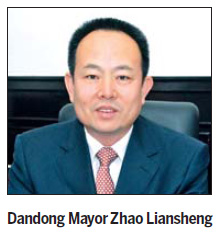|

Editor's note: The mayor of Dandong Zhao Liansheng, in Liaoning province, spoke with China Daily reporter Zhu Chengpei during the 2011 National People's Congress session in Beijing, on his city's remarkable development and its new initiatives.
Q: The Yalujiang New Bridge has caught a lot of attention recently. Could you enlighten us a bit on how it's going and its implications for the city's future?
A: The agreement on building that bridge across the Yalujiang was reached during Premier Wen Jiabao's visit to the Democratic Republic of Korea (DPRK), in October 2009.
Work on it began in Dandong, on Dec 31, 2010. We believe it will boost trade with the DPRK and, just as important, significantly benefit Dandong, which now handles 60 percent of the trade between the two countries.
Over the next five years, we believe Dandong's trade with DPRK will account for 50-60 percent of our total foreign trade volume.
When the bridge opens, container trucks can drive to the opposite side and Dandong can become a transportation hub connected to the Korean Peninsula, Japan, and even Southeast Asia.
We have the ability to offer services that integrate logistics, trade, tourism, bonded warehousing, and export processing. Our business links connect us to Liaoning, Jilin, Heilongjiang, and Hebei provinces as well as the Inner Mongolia autonomous region.
The Yalujiang New Bridge will spearhead development of the Europe-Asia land route and a crossroads on Asia's road network. So, Dandong is set to become a strategic China-DPRK link.
We believe our international trade volume will grow significantly and its image and position will rise.
Q: Could you tell us about some of the major achievements of last year?
A: Dandong played an important role in Liaoning's "Five point, one line" strategy, drawn up in 2006 as a blueprint for an economic belt encompassing five key cities. That put Dandong in the spotlight after the blueprint was accepted as a key national strategy in 2009.
The city's fastest development last year came with the Dagushan Economic Zone, a major part of the Dandong Coastal Economic Belt. The new area covers 30 square kilometers, and a quarter of our government's investment has gone into it.
Also, one half of our foreign investment has gone into it.
Also, work on a 200,000- ton iron-ore deep water deck began in 2010.
The city also attracted new investment, last year. For example, we started 1,500 projects worth more than 10 million yuan each, with total investment expected to reach 220 billion yuan.
Q: How would you comment on Dandong's development as an international port, and how will it build itself into the economic center for northeastern Asia?
A: Dandong is motivated by a new strategy.
With the opening of the Haiyang (Ocean) Red Port Area, a part of the Dagushan Economic Belt, last November, we entered a new era of development.
The area will help Dandong evolve into an international port with a handling capacity above 100 million tons.
A series of regional cooperation projects are also in place: one with the Haerbin-Daqing-Qiqihar Economic Corridor, one with the city of Dalian, and one with Yalujiang Economic Frontier Cooperation Zone. These will pave the way to economic growth and help us become regional center.
(China Daily 03/11/2011 page3)
|